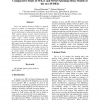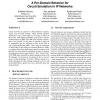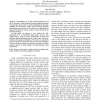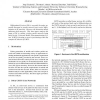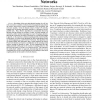128
Voted
JCIT
2010
14 years 7 months ago
2010
Voice over Internet Protocol (VoIP) is a general term for a family of transmission technologies to delivery of voice communications over IP networks such as the Internet or other ...
125
Voted
VTC
2010
IEEE
14 years 11 months ago
2010
IEEE
— The tolerable packet-loss ratio of an Internet Protocol (IP) based wireless networks varies according to the specific services considered. File transfer for example must be er...
129
Voted
CCR
2004
15 years 13 days ago
2004
Circuit networks are expensive to build, difficult to operate, fragile, and not easily scalable. Many network operators would like to carry circuit traffic as an overlay on top of...
104
Voted
JSW
2007
15 years 14 days ago
2007
— The efficiency of overlay networks built on top of the IP network is often threatened by the mismatch between the topologies of the overlay and the underlying IP network, resu...
107
Voted
DCOSS
2006
Springer
15 years 4 months ago
2006
Springer
The scope of wireless sensor network (WSN) applications has traditionally been restricted by physical sensor coverage and limited computational power. Meanwhile, IP networks like t...
110
Voted
LCN
2000
IEEE
15 years 5 months ago
2000
IEEE
Differentiated Services (DS) is currently the major approach discussed to provide network layer service differentiation in IP networks. However, the discussion mainly addresses �...
93
Voted
INFOCOM
2000
IEEE
15 years 5 months ago
2000
IEEE
Abstract— Knowledge of the up-to-date physical topology of an IP network is crucial to a number of critical network management tasks, including reactive and proactive resource ma...
165
Voted
POLICY
2001
Springer
15 years 5 months ago
2001
Springer
The Differentiated Services Architecture defines the mechanisms that are needed to offer multiple classes of services in an IP network. While this model offers significant scaling ...
91
Voted
ICMCS
2005
IEEE
15 years 6 months ago
2005
IEEE
We present a streaming media test bed for IP networks. Besides a streaming server and a streaming media client, it consists of an IP network emulator, a high-performance packet ca...
120
Voted
INFOCOM
2006
IEEE
15 years 6 months ago
2006
IEEE
— In this paper, we propose a simulation framework, TranSim, that reduces the rate at which packet-events are generated, in order to accelerate large-scale simulation of IP netwo...
